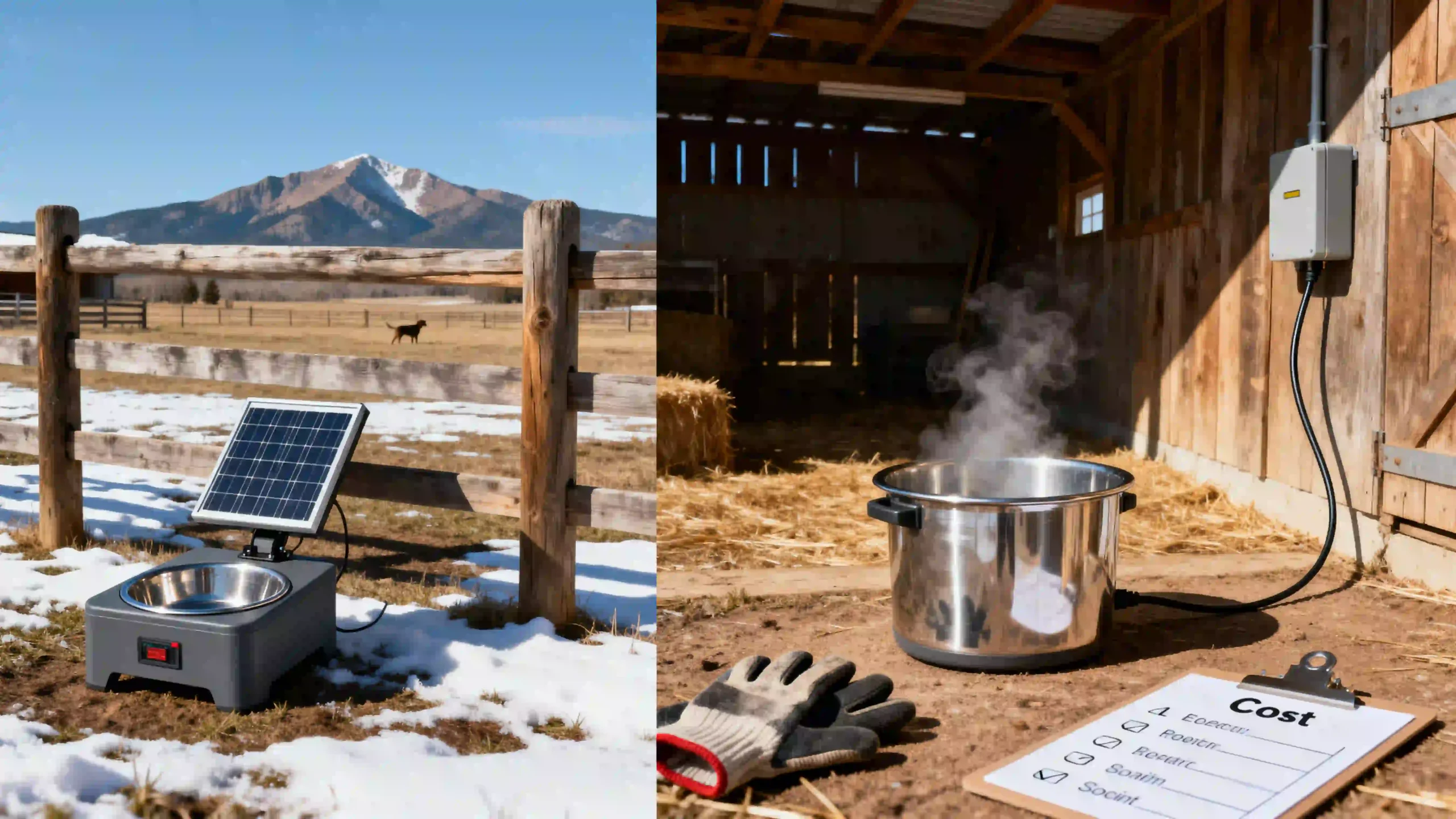Farms and ranches demand ruggedness. For working dogs outdoors year-round, providing consistent winter hydration can mean the difference between health and risk. When considering a solar heated dog bowl, it’s essential to compare it carefully with electric models in terms of durability, energy efficiency, and practicality. This article draws on real product data, user-reported failures, and environmental conditions to help you choose what’s best for your farm.
Solar Heated Dog Bowls: Strengths & Limitations
Strengths
- Off-grid potential: If your paddocks are far from power, solar options reduce dependency on generators or long extension runs.
- Energy-efficient pet products goal: solar has zero ongoing electricity use (once installed and charged). Over mild periods, solar-assisted heating or passive solar design (insulated bowls in sun, clear covers) can delay freeze.
Limitations
- Intermittent power supply: Cloud cover, short daylight hours, snow-covered panels drastically reduce output. Without adequate battery storage, nights may see freezing.
- Lower heat retention: Electric bowls with heavier insulation or metal surfaces retain heat better. Solar bowls or thermal solar designs often warm only shallow layers.
- Durability concerns: Panels, solar wiring, and batteries are vulnerable to farm conditions—mud, animal kicks, harsh cold. Many solar proposals in forums remain theoretical or small-scale.
Electric Heated Bowls: Reliable, but Need the Right Specs
What Works Well
- Bowls built for winter—insulated, thermostatically controlled, with strong cord protection—consistently succeed. For example, Farm Innovators’ 6-qt heated plastic bowl is cited as “effective solution for keeping water unfrozen in cold weather” and “durable, easy to clean, suitable size for larger pets.”
- K&H Thermal-Bowls receive commendations for maintaining water access below freezing, though users warn about wind chill exposing edges.
What to Ensure
- Thermostat or sensor control: turn on only when water nears freeze; prevents energy waste and overheating.
- Low-voltage or safe wiring practices: chew resist protectors for cords; sealed connection points; properly grounded outlets.
- Robust material: stainless steel, reinforced heat-safe plastics; metal doesn’t crack as easily as plastic in freeze-thaw cycles. See findings in Durability Test: Heated Dog Bowls That Survive Farm Life.
Comparing Solar vs Electric for Farm Use
| Criteria | Solar Heated Dog Bowl | Electric Heated Dog Bowl |
|---|---|---|
| Performance in subzero nights | Weak unless over-built with battery + insulation; often fails mid-night | Strong, reliable if specs match conditions; fewer surprises |
| Durability in mud / snow / abuse | Solar panels or batteries may get damaged; bowls might be less rugged | Built-for-winter bowls with stainless steel or thick plastic, strong cords perform better |
| Energy cost / infrastructure | Lower ongoing cost once setup; higher upfront for panel, battery, mounting | Higher electrical cost but simpler setup if grid available; good models moderate cost with thermostat |
| Maintenance demands | Solar requires battery checks, panel cleaning; less heat consistent | Electric models need cord inspections, element checks, insulation maintenance |
| Suitability for remote/off-grid areas | Solar has clear advantage off-grid; need spare parts and robust batteries | Possible via generator or solar power hybrid; but grid-connected is more dependable |
A Hybrid Approach: Best of Both Worlds
For many farms, the optimal solution is a hybrid:
- Use solar heated or solar-assisted bowls in remote pastures where power is hard to run. Accept that these may require more maintenance or backup during severe cold.
- Use electric heated bowls in main kennels, feedlots, barns where access, power, and shelter are better.
- One example: having WoofTrainer heated bowls in barn zones, and solar units or insulated waterers in far-out fields. It is a heavy-duty hydration solution built to tackle the harshest winter conditions. Crafted from food-grade 18/8 stainless steel (30 cm in diameter and 10 cm high), it ensures both durability and easy cleaning. Its core appeal lies in its safety and performance features: unlike high-voltage alternatives, it operates on a 24V low-voltage supply, eliminating the risk of electrical shock to pets and humans. Performance is guaranteed by a powerful 50W heating element that keeps water within an optimal 0°C to 20°C range, even in temperatures as low as -20 °C. For longevity and safety, the 1.3-meter power cord is protected by a chew-resistant stainless steel wrap, and the base is fitted with a rubber ring to prevent tipping. Offering superior safety, stability, and enduring performance, it is an ideal hydration solution for both dogs and livestock alike.
What to Look for Before Buying
When deciding between solar vs electric (or a hybrid), here are must-haves:
- Low temperature rating: specs should say something like “keeps water thawed at −20°F/−30°C” if you regularly see those cold nights.
- Insulation & bowl material: metal surfaces often outperform thin plastic; look for insulated walls, covers or windbreak designs.
- Cord protection and low voltage safety: cords wrapped/guarded; connectors sealed; safety features in case of moisture or animal interference.
- Battery / panel sizing (for solar): large enough panels and battery capacity to handle at least 24-hour freeze cycles if nights go long without sun.
- Manufacturer support and warranty: repairs or replacements after one season are common; choose suppliers with good reputations.
Considering Cost & Return on Investment
Electric bowls often cost more in energy, but:
- They reduce labor: fewer frozen water incidents, less ice-breaking, less bowl replacement.
- They tend to last longer if built for farm use.
- Solar setup has higher upfront cost (panels, batteries) and potentially shorter lifespan of electronic components unless ruggedized.
See analyses like The Cost Savings of Heated Dog Bowls for Large Properties where comparing energy use and labor saved shows electric units often pay for themselves over a few seasons.
Internal Resources That Help
- For broad comparisons and field tests, see Durability Test: Heated Dog Bowls That Survive Farm Life.
- For advice on managing hydration through extreme temperatures and outdoor conditions, see Heated Dog Bowls: The Complete Guide to Keeping Pets Hydrated in Winter.
Conclusion: Which Works Best for Your Farm
For most farms that have reliable access to electricity, electric heated dog bowls are the safer bet: stronger performance in extreme cold, less risk of unreliable heating, better durability. However, if your working dogs are in truly remote or off-grid paddocks, a solar heated dog bowl (or hybrid setup) with rugged panels, good battery backup, and insulated design may be appropriate. The best approach often combines both, placing electric bowls in high-use zones and solar units where wiring is impractical.
FAQ
1.Is a solar heated dog bowl ever as reliable as electric in −20°F (≈−29°C)?
Rarely by itself. Unless paired with large battery storage and excellent insulation, solar bowls typically struggle in nights that cold without backup heating.
2.Do solar bowls cost less over time than electric ones?
They can, particularly in sunny climates; but broken panels or batteries replace often, so you must price those into the long-term cost.
3.What maintenance differences will a farmer see between solar vs electric bowls?
Solar: panel cleaning, battery maintenance, checking for shading or snow cover. Electric: wiring inspections, element replacements, insulation checks. Electric tends to have fewer variables tied to weather.
4.Can solar and electric bowls share the same base power circuit or tools?
Yes—a hybrid system is possible. For example, electric bowls in main kennels, solar-powered or insulated units in pastures. But ensure solar-powered units have safe, weather-proof mounting and that electric wiring in hybrid settings meets safety code.
5.What safety features are essential in both types?
- Cord protection (chew-proof, waterproof)
- Overheat safety or cut-off thermostats
- Stable, tip-resistant bases
- Materials safe for extreme cold (no brittle plastics)
- For solar: battery charge protection; for electric: safe outlets (GFCI, waterproof if outdoors)
6.How do I size a solar heated dog bowl system for remote paddocks?
Calculate the worst-case energy requirement: how many hours of frost/low temp per night, desired water volume. Then size solar panel + battery to supply enough watt-hours. Also include some buffer for cloudy/short daylight days.


